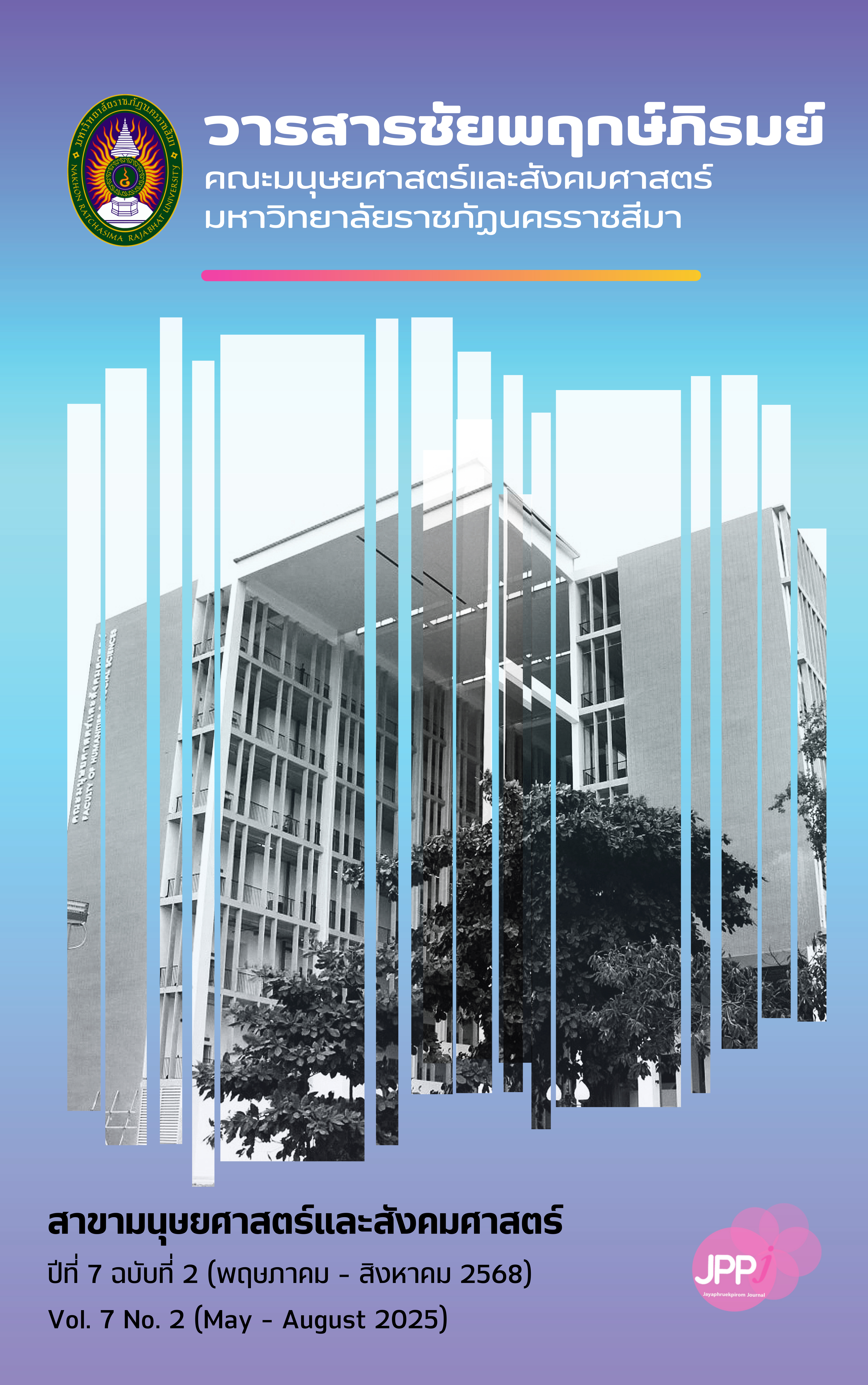THE COMPARATIVE STUDY OF FINAL CONSONANT AND TONES IN TAI ZHUANG AND BOUYEI LANGUAGES
Keywords:
Zhuang, Bouyei, Roman script, Pinyin, SawndipAbstract
The important languages using the Tai Roman script in China are the Bouyei and modern Zhuang. The closeness of the Zhuang and Puyi languages and cultures, which are in the Tai language group that also use the Roman script, enables a comparative study of phonemes, vowels, consonants, and tones. This shows that vowels without a final consonant can be compared to the Mae K Ka and Chinese pinyin. As for the final vowels followed by a final consonant, the Zhuang and Bouyei languages are: 1) Mae Kei (เกย) 2) Mae Know (เกอว) 3) Mae Kon (กน) 4) Mae Gong (กง) 5) Mae Kom (กม) 6) Mae Kob (กบ) 7) Mae Kod (กด) 8) Mae Kok (กก), which are comparable to all 8 consonant measures and including Mae K Ka too. The Zhuang language uses t (ท) while Puyi uses d (ต) as the final consonant of Mae Kod (กด)
The tones of Zhuang and Bouyei are similar, but some tones are different, namely the second tone and the fourth tone, although they have different pitches, are considered minor tones of the first tone. Both tones also exist in Thai. Bouyei has 8 tones, with the 7th tone being the same as the 3rd and 8th tones, which are the same as the 6th tone. Puyi's 7 (3) and 8 (6) are probably more influenced by Cantonese than Mandarin.
References
กรรณิการ์ วิมลเกษม. (2549). ภาษาไทยถิ่นเหนือ. พิมพ์ครั้งที่ 2. ภาควิชาโบราณคดี สาขาวิชาภาษาตะวันออก มหาวิทยาลัยศิลปากร วังท่าพระ. กรุงเทพฯ: โรงพิมพ์บริษัทธรรมสารจำกัด.
จุมพล ถาวรชอบ และเทวากร คำสัตย์. (มกราคม-มิถุนายน 2567). การศึกษาลักษณะทางกลสัทศาสตร์เสียงวรรณยุกต์ภาษาไทยของนักศึกษาชาวจีน สาขาวิชาภาษาไทย สถาบันผู่เจียงแห่งมหาวิทยาลัยอุตสาหกรรมนานกิงสาธารณรัฐประชาชนจีน. วารสารศิลปะศาสตร์ปริทัศน์. 19(1), น. 127-149.
ธัญญารัตน์ มะลาศรี และเว่ย จิ้งหรู. (2561). ลักษณะเด่นของอักษรกระดองเต่า. วารสารวิชาการคณะมนุษยศาสตร์และสังคมศาสตร์ มหาวิทยาลัยราชภัฏพระนครศรีอยุธยา. 6(1), น. 77-92.
ปภาดา ทวีอักษรพันธ์. (มกราคม - มิิถุุนายน 2565). การศึกษาระบบเสียงภาษาจีนกวางตุ้งในประเทศไทย. วารสารวิิชาการภาษาและวััฒนธรรมจีน. 9(1), น. 231-248.
ปิยะวรรณ กลีบศรี. (2538). การเขียนพยัญชนะไทยด้วยอักษรโรมันสมัยรัตนโกสินทร์. วิทยานิพนธ์ศิลปะศาสตร์มหาบัณฑิต คณะศิลปศาสตร์ มหาวิทยาลัยธรรมศาสตร์.
พจนี ศิริอักษรสาสน์. (2545). ภาษาถิ่นของไทย FL 323. มหาวิทยาลัยรามคำแหง. กรุงเทพ ฯ: โรงพิมพ์มหาวิทยาลัยรามคำแหง.
พรทิพย์ เฉิดฉินนภา. (พฤศจิกายน 2546). การเปลี่ยนแปลงระบบการเขียนในสมัยรัตนโกสินทร์. วารสารวรรณวิทัศน์. มหาวิทยาลัยธรรมศาสตร์. ปีที่ 3, น. 7-30.
ยุทธพร นาคสุข. (มปป). เอกสารประกอบการสอนวิชา LCLG 597 อักษรไท (Tai Orthography). มหาวิทยาลัย มหิดล วิทยาเขตศาลายา. นครปฐม: มหาวิทยาลัยมหิดล.
เมชฌ สอดส่องกฤษ. (กรกฎาคม - ธันวาคม 2557). ภาษาปู้อี: ภาษาที่ใกล้ชิดกบภาษาไทยในประเทศจีน. วารสารกระแสวัฒนธรรม. 15 (28), 67–76.
__________. (กรกฎาคม - ธันวาคม 2558). ภาษาจ้วง: ภาษาไทในประเทศจีนตามทรรศนะของนักวิชาการจีน. วารสารกระแสวัฒนธรรม. 16 (30), 68–81.
วริษา กมลนาวิน. (กรกฎาคม - ธันวาคม 2546). การวิเคราะห์ระบบเสียงวรรณยุกต์ของชาวกรุงศรีอยุธยาจากเสียงเจรจาโขนและจินดามณี. วารสารศิลปศาสตร์ มหาวิทยาลัยธรรมศาสตร์. 3(2), น. 28-54.
วิภา จิรภาไพศาล. (2563). 13 มกราคม 2449 วันเกิด “โจวโหย่วกวง” นักภาษาศาสตร์ผู้ได้ชื่อว่า “บิดาระบบ พินอิน”. (ออนไลน์).
ศิลปวัฒนธรรม. สืบค้นเมื่อ 30 พฤศจิกายน 2567. จาก: https://www.silpa-mag.com/this-day-in-history/article_44043.
วิภาศรี จ้อยสูงเนิน. (2537). การแก้ไขการออกเสียงวรรณยุกต์ในภาษาไทยของนักเรียนระดับ 8 โรงเรียนนานาชาติ เชียงใหม่ โดยการแทนเสียงด้วยตัวอักษรอย่างมีระบบ. การค้นคว้าแบบอิสระ ศึกษาศาสตรมหาบัณฑิต, สาขาวิชาการสอนภาษาไทย มหาวิทยาลัยเขียงใหม่.เชียงใหม่ : บัณฑิตวิทยาลัย มหาวิทยาลัย เชียงใหม่.
หลี่หมิงเสียน. (2020). พัฒนาการของตัวอักษรจีน. (ออนไลน์). อาศรมสยาม-จีนวิทยา, บริษัทซีพีออลล์จำกัด (มหาชน) และสมาคมปัญญาภิวัฒน์. สืบค้นเมื่อ 2 ธันวาคม 2567. จาก: https://www.arsomsiam .com/evolution-of-chinese-characters/.
Omniglot. (n. d.). Zhuang (Vahcuengh / Vaƅcueŋƅ / 話僮). (Online). Retrieved Nov. 30, 2024. from: https://www.omniglot.com/writing/zhuang.htm.
Peter Ladefoged. (2018). Chinese, Standard (Tone) “The tones of Standard Chinese”. (Online). UCLA Phonetics Lab Data, Index of languages. Nov. 30, 2024. from: https://phonetics. ucla.edu/vowels/chapter2/chinese/recording2.1.html
Tilman Aretz. (2018). “Hanyu Phinyin” A Guide to the Pronunciation and Romanization of Modern Chinese. (Pdf Online). A Wonderful Taiwan Forum publication. Retrieved Nov. 30, 2024. from: https://www.taiwan-database.net/PDFs/WTFpdf03.pdf. pp. 1-29.
Wai-Sum Lee and Eric Zee. (2003). Standard Chinese (Beijing). Journal of the International Phonetic Association. (Pdf online). International Phonetic Association. Printed in the United Kingdom. 33(1), pp.
-102. Retrieved Nov. 30, 2024. from: https:// www.cambridge.org/core/services/aop-cambridge-core/content/view/050A393A F2D3C325E3C6796FE8CA99A3/S0025100303001208a.pdf/standard_chinese _beijing .pdf.
Wang Dan and Zhang Xiancheng. (2016). Study on Zhuang People’s Cognitive Situation from the Perspective of Sawndip’s Semantic Component: Based on Animals and Plants Sawndip. Studies in Literature and Language, Canadian Academy of Oriental and Occidental Culture (CSCanada). 12(1), pp. 5-8.
Zee, Eric (1999), "Chinese (Hong Kong Cantonese)". (Pdf online). Handbook of the International Phonetic Association: A guide to the use of the International Phonetic Alphabet, Cambridge: Cambridge University Press. Retrieved Nov. 30, 2024. from: https://sail.usc.edu/~ lgoldste/General_Phonetics/Final_Project/Chinese.pdf. pp, 58-61.


